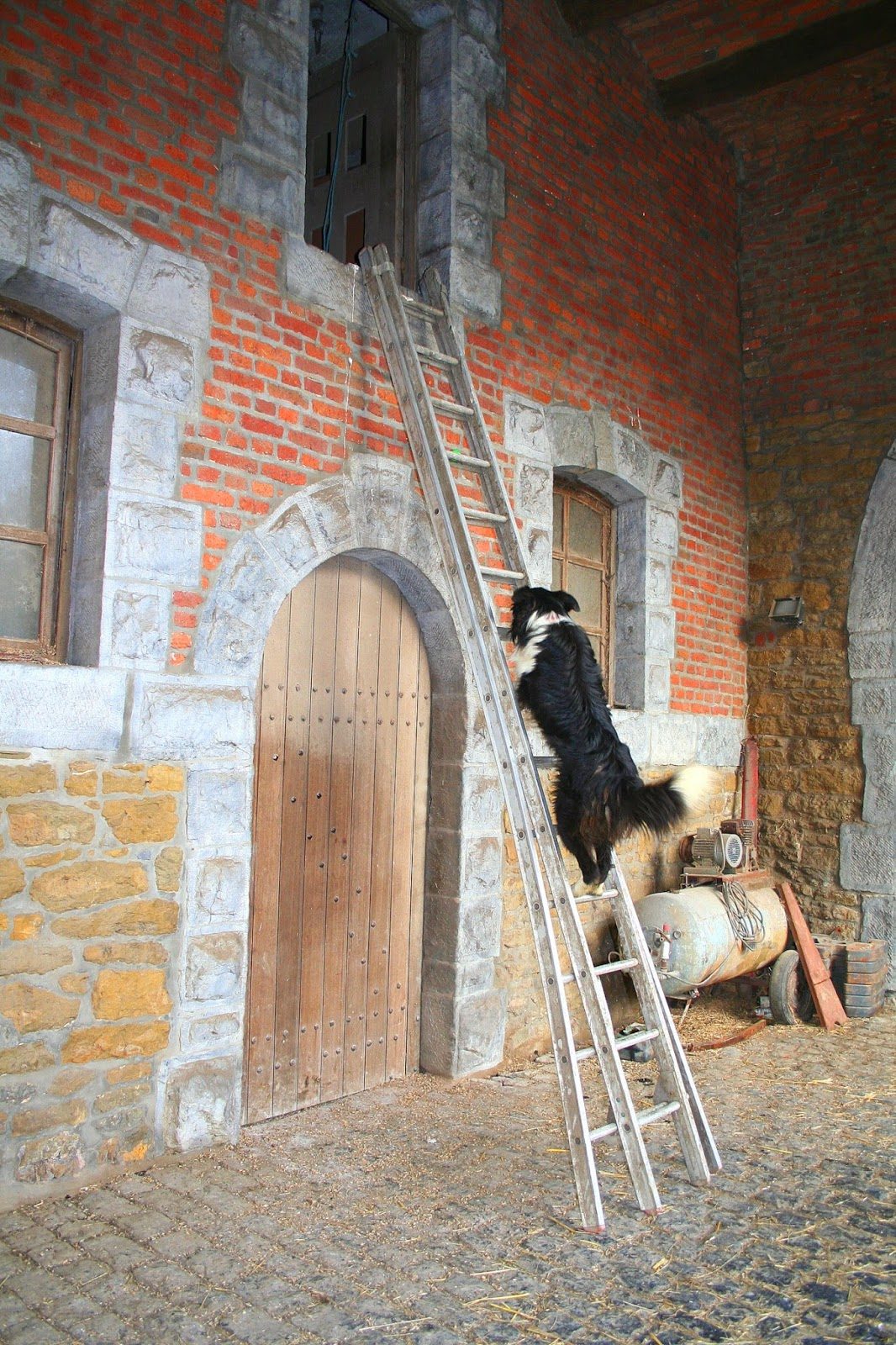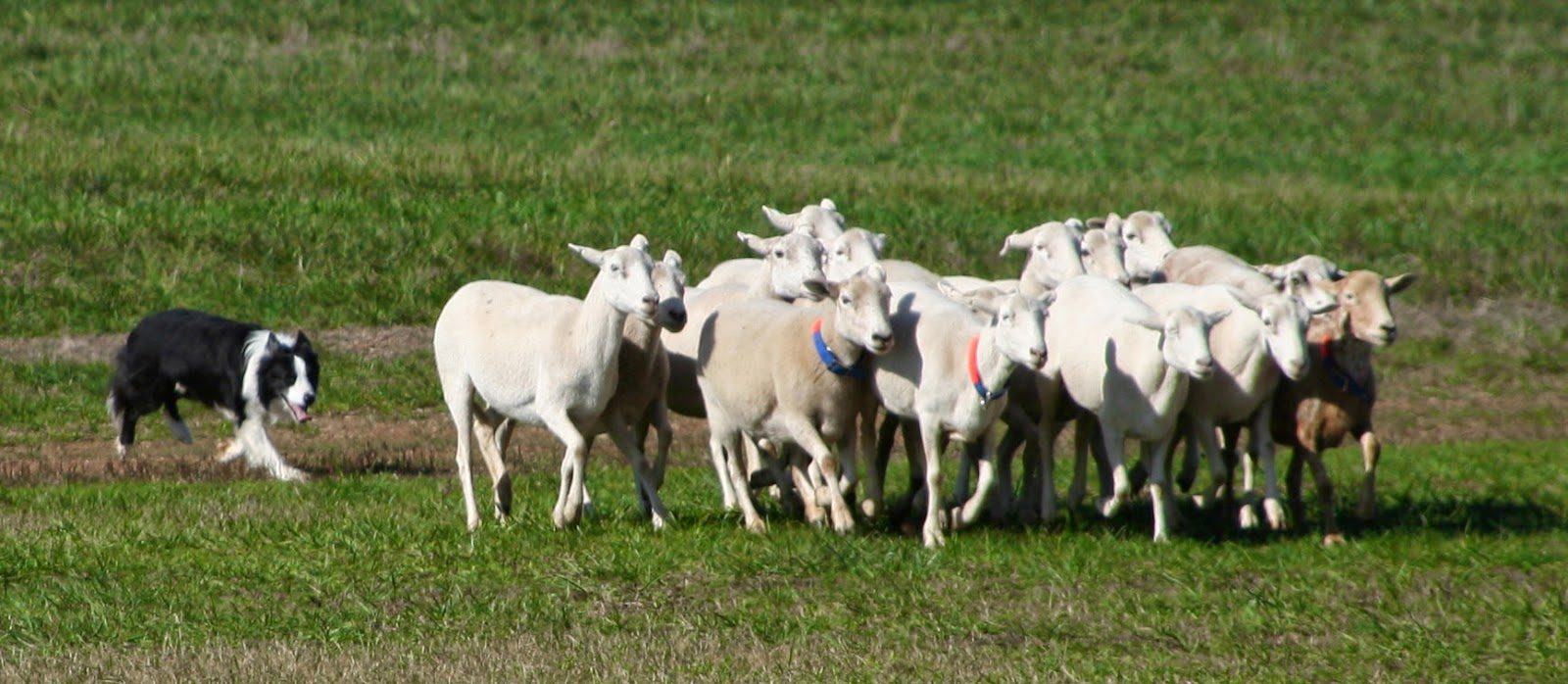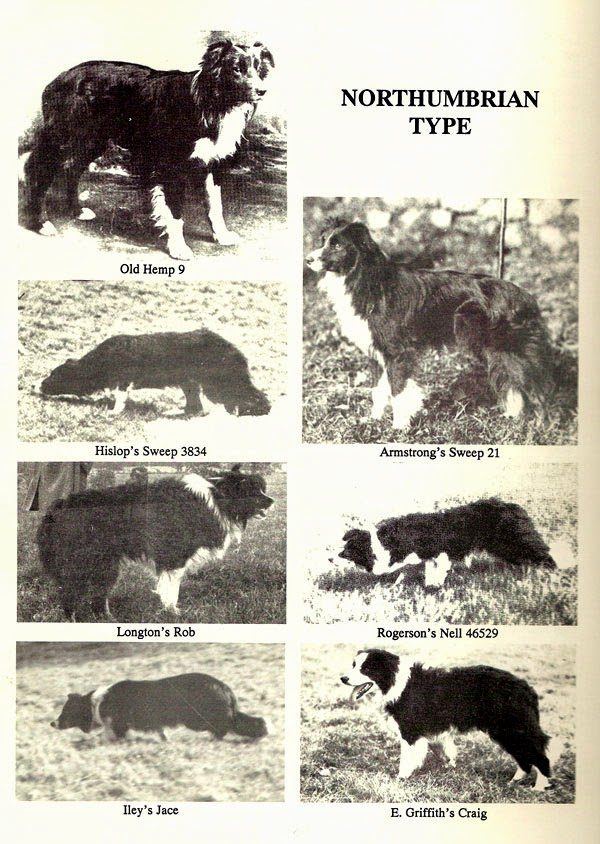Breed standards
UKC group: Herding Dog
Average lifespan: 12 – 16 years
Average size: 30 – 45 pounds
Coat appearance: Varies
Coloration: Black and red
Hypoallergenic: No
Other identifiers: Known for its eye movement, you’ll likely spot this breed giving a hypnotic stare while crouching down to herd stock
Possible alterations: NoneComparable Breeds: Golden Retriever, Collie
Other Quick Facts
- Border Collies are frighteningly smart, active workaholics who must have a job that can be as simple as chasing a tennis ball or as demanding as training for something like herding, agility obedience, or freestyle. What the job is doesn’t matter so much as that the Border has a job.
- The Border is an excellent watchdog and will alert you to the arrival of the letter carrier, a burglar, or a squirrel. Some can become nuisance barkers.
- Borders are very people-oriented and are wonderful family dogs.
- Some Borders are not good with other dogs or cats, and some are great.
- Border Collies are the best working breed in the world for sheepherding. They also excel at performance activities such as agility, obedience, flyball, and freestyle, among others.
Size
Males stand 19 to 22 inches tall and weigh 35 to 45 pounds. Females stand 18 to 21 inches and weigh 30 to 40 pounds.
Personality
Quite simply, the Border Collie is a dynamo. His personality is characteristically alert, energetic, hardworking, and smart. He learns quickly — so quickly that it’s sometimes difficult to keep him challenged.
This breed likes to be busy. In fact, he must be busy or he becomes bored, which leads to annoying behavior, such as barking, digging, or chasing cars. He’s not a dog to lie quietly on the front porch while you sip a glass of lemonade; he thrives on activity. Remember, he was bred to run and work all day herding sheep.
The Border Collie is also renowned for being highly sensitive to his handler’s every cue, from a whistle to a hand signal to a raised eyebrow.
Of course, the Border Collie isn’t perfect. He can be strong-minded and independent, and his compulsion to herd can become misdirected. In the absence of sheep, or some kind of job, he is apt to gather and chase children, cars, or pets.
He can also become fearful or shy if he isn’t properly socialized as a puppy. Puppy classes and plenty of exposure to a variety of people, places, and things help the sensitive Border Collie gain confidence.
Is this breed right for you?
Although the Border Collie is a sweet and loyal pup and can be a great family dog, it’s not recommended for everyone. This breed requires incredible amounts of activity and due to its level of intelligence, you must keep its mental abilities piqued with daily work and training. Without the proper time dedication, this breed can become bored and destructive. Luckily, this pup’s grooming routine is a breeze so time spent brushing or bathing can be kept to a minimum, providing more time to play and work.
How to Care for a Border Collie- Steps
1.Consider carefully. Border Collies (also known as BCs) exceed almost every other dog breed in intelligence and energy, and are only for responsible, dedicated, informed, and experienced dog owners. Never buy a BC because of their cute appearance, or because your friend has a really nice one, and always dedicate a large amount of research before purchasing.
2.Choose where to purchase your Border Collie from. Responsible breeders are the best source for those who desire a show or competition dog; however, if you are interested simply in a pet quality, consider adopting from a specialized breed rescue. Other routes include:
- Buying from a pet store. This is highly unrecommended, as you will generally have no idea of the puppy’s health, breeding, or history, and will most likely be supporting a puppy mill.
- Buying from a “backyard,” or casual, breeder. This is again unadvised for the lack of information.
- Adopting from a shelter. This is a preferred route for those wishing to help dogs in need, but is unadvised for the lack of information and because shelters are often unable to provide for the BC’s special needs, resulting in a badly behaved dog. Adopting from a breed-specific rescues, however, is a reasonable and kind way to acquire your dog.
3. Obedience training is essential. Not only will it provide essential stimulation for your BC, it will also make your life with a extremely energetic, mischievous dog somewhat easier. Though you can start teaching simple concepts to young puppies using positive reinforcement, training more advanced obedience is only recommended for puppies four months and older. Another note is that Border Collies are intelligent dogs and often respond best to training techniques in which they can think problems out for themselves, such as clicker training.
4.Go on a shopping spree! The basic essential you’ll need to buy your BC are:
- A collar and leash. They should be an appropriate length for your Border Collie, and comfortable for you and your dog. The collar must have a ID tag with your phone number or address on it.
- Food (see below for more information) and food and water dishes, preferably stainless steel.
- Toys! Purchase “indestructible” ones such as Kongs; these will last longer (though most will be destroyed eventually) than stuffed toys and dainty rubber squeaky toys.
- A crate, appropriately sized.
- Grooming tools, especially those appropriate for long-haired dogs.
5.Give your Border Collie quality veterinarian care. Though this will cost a large amount, it will save you money down the road. It’s highly recommended that you do the following:
- Fix (spay or neuter) your dog. This is a relatively simple operation that will help stop or prevent bad behavior, accidental litters, and certain health issues.
- Give your puppy vaccinations. These are absolutely necessary for his health; consult your veterinarian for information on required vaccinations and appropriate ages at which to give them.
- Purchase your dog a microchip. A microchip is a very small device that will give a shelter, if your BC escapes, your address. Because of Border Collies’ intelligence and agility, the chances of your BC escaping is high enough that a microchip is a useful precaution.
6.Good food is necessary. Avoid cheap or “bargain” foods – the health problems they’ll cause won’t be cheap to treat! Instead, feed high-quality foods with meat as the main ingredient.
7.Exercise, exercise, exercise! Because of Border Collies’ enormous amounts of energy, at least an hour of exercise every day is a requirement. A daily walk is necessary; you can also burn off energy in more engaging ways such as competing in dog sports such as Agility or Flyball, hiking, swimming, visiting dog parks, etc.
8.Expand your education. Read books on Border Collies, join a Obedience/Agility/etc group, talk with experienced BC owners, try out something you’ve never done before, learn more about dog nutrition – do anything and everything to learn as much about BCs and dogs in general as possible.
9.Have fun with your Border Collie! He might need an hour and a half of exercise every day, shred your expensive shoes, herd the neighborhood children, or otherwise make a menace of himself, but one thing is for certain: If you’re a responsible and educated owner, he’ll be your best friend.
Health
Border Collies are generally healthy, but like all breeds, they’re prone to certain health conditions. Not all Border Collies will get any or all of these diseases, but it’s important to be aware of them if you’re considering this breed.
If you’re buying a puppy, find a good breeder who will show you health clearances for both your puppy’s parents. Health clearances prove that a dog has been tested for and cleared of a particular condition.
In Border Collies, you should expect to see health clearances from the Orthopedic Foundation for Animals (OFA) for hip dysplasia (with a score of fair or better), elbow dysplasia, hypothyroidism, and von Willebrand’s disease; from Auburn University for thrombopathia; and from the Canine Eye Registry Foundation (CERF) certifying that eyes are normal. You can confirm health clearances by checking the OFA web site (offa.org).
Hip Dysplasia: This is an inherited condition in which the thighbone doesn’t fit snugly into the hip joint. Some dogs show pain and lameness on one or both rear legs, but others don’t display outward signs of discomfort. (X-ray screening is the most certain way to diagnose the problem.) Either way, arthritis can develop as the dog ages. Dogs with hip dysplasia should not be bred — so if you’re buying a puppy, ask the breeder for proof that the parents have been tested for hip dysplasia and are free of problems.
Progressive Retinal Atrophy (PRA): This is a family of eye diseases that involves the gradual deterioration of the retina. Early in the disease, affected dogs become night-blind; they lose sight during the day as the disease progresses. Many affected dogs adapt well to their limited or lost vision, as long as their surroundings remain the same.
Epilepsy: This is a neurological condition that’s often, but not always, inherited. Epilepsy can cause mild or severe seizures that may show themselves as unusual behavior (such as running frantically as if being chased, staggering, or hiding) or even by falling down, limbs rigid, and losing consciousness. Seizures are frightening to watch, but the long-term prognosis for dogs with idiopathic epilepsy is generally very good. It’s important to take your dog to the vet for proper diagnosis (especially since seizures can have other causes) and treatment.
Collie Eye Anomaly: This is an inherited condition that causes changes and abnormalities in the eye, which can sometimes lead to blindness. These changes can include choroidal hypoplasia (an abnormal development of the choroids), coloboma (a defect in the optic disc), staphyloma (a thinning of the sclera), and retinal detachment. Collie eye anomaly usually occurs by the time the dog is two years old. There is no treatment for the condition.
Allergies: There are three main types of allergies in dogs: food allergies, which are treated by eliminating certain foods from the dog’s diet; contact allergies, which are caused by a reaction to a topical substance such as bedding, flea powders, dog shampoos, and other chemicals; and inhalant allergies, which are caused by airborne allergens such as pollen, dust, and mildew. Treatment varies according to the cause and may include dietary restrictions, medications, and environmental changes.
Osteochondrosis Dissecans (OCD): This orthopedic condition, caused by improper growth of cartilage in the joints, usually occurs in the elbows, but it has been seen in the shoulders as well. It causes a painful stiffening of the joint, to the point that the dog is unable to bend his elbow. It can be detected in dogs as early as four to nine months of age. Overfeeding of “growth formula” puppy foods or high-protein foods may contribute to its development.
Care
While the Border Collie is a highly adaptable dog, he’s best suited to an environment that gives him some elbow room: a city home with a securely fenced yard, or a country farm or ranch. Because he has a propensity to herd and chase, he must be protected from his not-so-bright instinct to chase cars.
Regardless of the environment, he requires a great deal of mental and physical stimulation every day, and he needs an owner who is willing and able to provide that. This can be a great burden to owners who don’t know what they’re getting into. If you’re considering a Border Collie, make sure you can provide him with a proper outlet for his natural energy and bright mind. If you don’t have a farm with sheep, dog sports are a good alternative.
Feeding
Recommended daily amount: 1.5 to 2 cups of high-quality dry food a day, divided into two meals.
NOTE: How much your adult dog eats depends on his size, age, build, metabolism, and activity level. Dogs are individuals, just like people, and they don’t all need the same amount of food. It almost goes without saying that a highly active dog will need more than a couch potato dog. The quality of dog food you buy also makes a difference — the better the dog food, the further it will go toward nourishing your dog and the less of it you’ll need to shake into your dog’s bowl.
The Basics of Border Collie Grooming
The Border Collie has a double coat that comes in two types. One is short and smooth, sometimes with a bit of feathering on the front legs. The other, known as a rough coat, is medium to long with hair that is flat or slightly wavy. Either way, expect to brush a Border Collie once or twice a week to remove dead hair and keep shedding to a minimum.
Otherwise, just keep his ears clean and bathe him if he gets dirty. The rest is basic care. Trim the nails as needed. Active Border Collies often wear their nails down naturally, but it’s a good idea to check them weekly to see if they need a trim. Brush the teeth frequently for overall good health and fresh breath.
Children and other pets
The Border Collie is a good family dog, as long as he is raised properly and receives training when he’s young. He gets along with children and other pets, though his instinct to herd will cause him to nip, chase, and bark at kids (especially very young children) and animals if his herding instincts aren’t otherwise directed.
As with every breed, you should always teach children how to approach and touch dogs, and always supervise any interactions between dogs and young children to prevent any biting or ear or tail pulling on the part of either party. Teach your child never to approach any dog while he’s eating or sleeping or to try to take the dog’s food away. No dog, no matter how friendly, should ever be left unsupervised with a child.
Rescue Groups
Border Collies are often purchased without any clear understanding of what goes into owning one. There are many Border Collies in need of adoption and or fostering. There are a number of rescues that we have not listed. If you don’t see a rescue listed for your area, contact the national breed club or a local breed club and they can point you toward a Border Collie rescue.
Notable animals
Border Collies of note include:
- Rico, who was studied for recognising up to 200 objects by name. Another Border Collie, Betsy, was found to have a vocabulary of over 300 words.
- As of 2010, the Border Collie Chaser has a vocabulary of 1022 words and is able to recognise objects by the groups they belong to.
- Shep, who was the long-term companion to John Noakes of the BBC’s Blue Peter and Meg, companion of Matt Baker, former presenter of the same show.
- Striker, who is the current Guinness World Record holder for “Fastest Car Window Opened by a Dog” at 11.34 seconds.
- Jean, a.k.a. the Vitagraph Dog who was the first canine movie star (owned and trained by Laurence Trimble)
- Rex and Fly are two Border Collies that appeared in the Academy Award winning 1995 film, Babe and, partially, in the sequel Babe: Pig in the City.
- Jag, the “First Dog” of Montana, frequently accompanies Governor Brian Schweitzer.
- Bandit, the stray Scottish border collie from TV series Little House on the Prairie was Laura Ingalls’ second dog on the show. Laura was reluctant to make friends with Bandit as she missed first dog Jack, but she soon loved Bandit dearly. Bandit premiered in the second season of the show and remained a steady extra for the next three seasons.
- Murray, Border Collie Mix in the TV show Mad About You.
- Mist and other dogs, including Jake, of Borough Farm on Windcutter Down in England. They were featured in two books by author and owner David Kinnard and starred in a series of television films and weekly programs called “Mist: Sheepdog Tales” on BBC television, several of which are available in the US.
Did You Know?
Border Collies are known as herding dogs, but a BC currently holds the Guinness World Record for Fastest Car Window Opened by a Dog. Striker, a Border Collie from Hungary, opened the non-electric window in 11.34 seconds. Impressive!
In popular culture
The primary character of the New Zealand comic strip Footrot Flats and the 1986 animated film adaptation Footrot Flats: The Dog’s Tail Tale is a working Border Collie named “Dog”. Although the strip featured numerous human and farm animal characters it was told from the Dog’s point of view.
In the film, Babe, the piglet Babe is adopted by a working Border Collie named Fly and taught by her to herd sheep.

A dream day in the life of a Border Collie
Learning new games with the Frisbee, taking on higher levels of training or starting a new agility course makes a day this pup would want to repeat over and over. Staying true to his natural instincts, the Border Collie would love a job herding sheep or cattle on a farm. Border Collies are the overachievers of the canine group, so keep this pup’s schedule jam-packed with activities and you’ll have a happy pup.
Enjoy that Border Collie!





